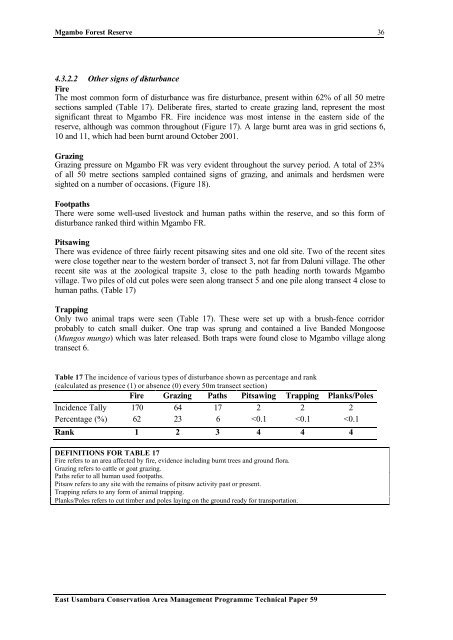Mgambo Forest Reserve: A biodiversity survey. - Eastern Arc ...
Mgambo Forest Reserve: A biodiversity survey. - Eastern Arc ...
Mgambo Forest Reserve: A biodiversity survey. - Eastern Arc ...
You also want an ePaper? Increase the reach of your titles
YUMPU automatically turns print PDFs into web optimized ePapers that Google loves.
<strong>Mgambo</strong> <strong>Forest</strong> <strong>Reserve</strong><br />
36<br />
4.3.2.2 Other signs of disturbance<br />
Fire<br />
The most common form of disturbance was fire disturbance, present within 62% of all 50 metre<br />
sections sampled (Table 17). Deliberate fires, started to create grazing land, represent the most<br />
significant threat to <strong>Mgambo</strong> FR. Fire incidence was most intense in the eastern side of the<br />
reserve, although was common throughout (Figure 17). A large burnt area was in grid sections 6,<br />
10 and 11, which had been burnt around October 2001.<br />
Grazing<br />
Grazing pressure on <strong>Mgambo</strong> FR was very evident throughout the <strong>survey</strong> period. A total of 23%<br />
of all 50 metre sections sampled contained signs of grazing, and animals and herdsmen were<br />
sighted on a number of occasions. (Figure 18).<br />
Footpaths<br />
There were some well-used livestock and human paths within the reserve, and so this form of<br />
disturbance ranked third within <strong>Mgambo</strong> FR.<br />
Pitsawing<br />
There was evidence of three fairly recent pitsawing sites and one old site. Two of the recent sites<br />
were close together near to the western border of transect 3, not far from Daluni village. The other<br />
recent site was at the zoological trapsite 3, close to the path heading north towards <strong>Mgambo</strong><br />
village. Two piles of old cut poles were seen along transect 5 and one pile along transect 4 close to<br />
human paths. (Table 17)<br />
Trapping<br />
Only two animal traps were seen (Table 17). These were set up with a brush-fence corridor<br />
probably to catch small duiker. One trap was sprung and contained a live Banded Mongoose<br />
(Mungos mungo) which was later released. Both traps were found close to <strong>Mgambo</strong> village along<br />
transect 6.<br />
Table 17 The incidence of various types of disturbance shown as percentage and rank<br />
(calculated as presence (1) or absence (0) every 50m transect section)<br />
Fire Grazing Paths Pitsawing Trapping Planks/Poles<br />
Incidence Tally 170 64 17 2 2 2<br />
Percentage (%) 62 23 6
















